
The Canary Islands, also known informally as the Canaries, are a Spanish region, autonomous community and archipelago in the Atlantic Ocean. At their closest point to the African mainland, they are 100 kilometres west of Morocco and the Western Sahara. They are the southernmost of the autonomous communities of Spain. The islands have a population of 2.2 million people and are the most populous special territory of the European Union.
Santa Cruz or Santacruz may refer to:

Santa Cruz de Tenerife, commonly abbreviated as Santa Cruz, is a city, the capital of the island of Tenerife, Province of Santa Cruz de Tenerife, and one of the capitals of the Canary Islands, along with Las Palmas. Santa Cruz has a population of 206,593 (2013) within its administrative limits. The urban zone of Santa Cruz extends beyond the city limits with a population of 507,306 and 538,000 within urban area. It is the second largest city in the Canary Islands and the main city on the island of Tenerife, with nearly half of the island's population living in or around it.
San Juan Bautista is the Spanish-language name of Saint John the Baptist. It may refer to:

Old San Juan is a historic district located at the "northwest triangle" of the islet of San Juan in San Juan. Its area roughly correlates to the Ballajá, Catedral, Marina, Mercado, San Cristóbal, and San Francisco sub-barrios (sub-districts) of barrio San Juan Antiguo in the municipality of San Juan, Puerto Rico.
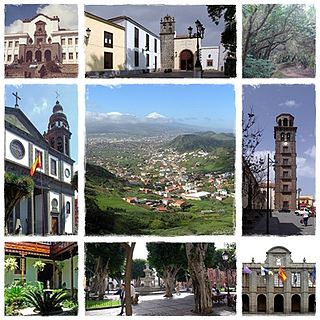
San Cristóbal de La Laguna is a city and municipality in the northern part of the island of Tenerife in the Province of Santa Cruz de Tenerife, on the Canary Islands, Spain. The former capital of the Canary Islands, the city is the third-most populous city of the archipelago and the second-most populous city of the island.

La Asunción is a city in Venezuela. The capital of Nueva Esparta state, it lies on Margarita Island in the Caribbean Sea, off the South American mainland. It is situated in a fertile valley surrounded by green hills, 6 miles (10 km) inland from the port of Porlamar, where a cooler climate exists. The city was founded in 1565 by Captain Pedro González Cervantes de Albornoz. It has an imposing backdrop of Santa Rosa Castle, also known as the Santa Rosa Fort, which was built to protect the city. The most important structures in the city are built around the Plaza Bolívar. The Catedral Nuestra Señora de La Asunción, dated to the 16th century, is one of the earliest churches in the country. According to the 2011 census, it has a population of 28,513 people.

Alonso Fernández de Lugo was a Spanish conquistador, city founder, and administrator. He conquered the islands of La Palma (1492–1493) and Tenerife (1494–1496) for the Castilian Crown; they were the last of the Canary Islands to be conquered by Europeans. He was also the founder of the towns of San Cristóbal de La Laguna, Santa Cruz de Tenerife and Santa Cruz de La Palma. One biographer has written that his personality was a “terrible mixture of cruelty and ambition or greed, on one part, and on the other a great capacity and sense for imposing order and government on conquered lands,” a trait found in the conquistadors of the New World.

The Catedral Basílica Metropolitana de San Juan Bautista, or in English, Metropolitan Cathedral Basilica of Saint John the Baptist, is the Catholic cathedral for the Archdiocese of San Juan de Puerto Rico. It is one of the oldest buildings in Old San Juan, the oldest cathedral in the United States, the second-oldest existing cathedral in the Americas, and the third cathedral constructed in the Americas.
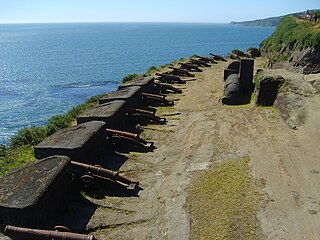
The Fort System of Valdivia is a series of Spanish colonial fortifications at Corral Bay, Valdivia and Cruces River established to protect the city of Valdivia, in southern Chile. During the period of Spanish rule (1645–1820), it was one of the biggest systems of fortification in the Americas. It was also a major supply source for Spanish ships that crossed the Strait of Magellan.
The Battle of Santa Cruz de Tenerife was a minor military action of the War of the Spanish Succession during which an English fleet of 13 ships under the command of Admiral John Jennings attempted unsuccessfully to seize the city of Santa Cruz de Tenerife. Jennings previously relied on the English triumphs in the Iberian Peninsula demanding recognition for the sovereignty of Charles II of England over the Canary Islands, but their offers were rejected.

The Battle of Santa Cruz de Tenerife was a military operation in the Anglo-Spanish War (1654–60) which took place on 20 April 1657. An English fleet under Admiral Robert Blake penetrated the heavily defended harbour at Santa Cruz de Tenerife in the Spanish Canary Islands and attacked their treasure fleet. The treasure had already been landed and was safe but the English engaged the harbour forts and the Spanish ships, many of which were scuttled and the remainder burnt. Having achieved his aim, Blake withdrew without losing any ships.
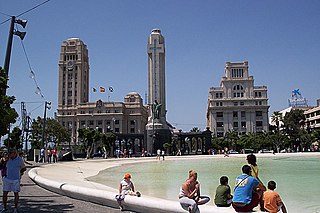
Plaza de España, is the largest square in the city of Santa Cruz de Tenerife and the Canary Islands (Spain). The square is located in the centre of town, 1.4 km north of the Auditorio de Tenerife. This square is considered one of the "main squares" of the island of Tenerife, together with the Plaza del Cristo de La Laguna in San Cristóbal de La Laguna and the Plaza de la Patrona de Canarias in Candelaria. It hosts an artificial lake fountain, a work of Swiss architects Herzog & de Meuron.

The Castle of San Andrés or Tower of San Andrés is located in the village of San Andrés. This castle served to protect the island of Tenerife from pirate attacks.

The Castle of San Cristóbal in Santa Cruz de Tenerife was the first fortification of significance on the island of Tenerife and the main defensive building on Santa Cruz Bay. The central Castle Street is named after this fort.
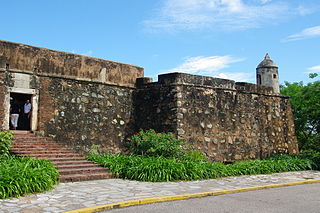
Santa Rosa de la Eminencia castle is a colonial castle built in the seventeenth century by the Spanish monarchy on Margarita Island, Venezuela. After a group of French pirates attacked the city of La Asunción, its construction started on 24 March 1677, by order of governor Juan Muñoz de Gadea, and it was finished c. 1683.
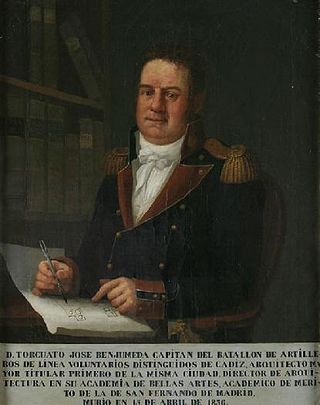
Torcuato José Benjumeda y Laguada was a Spanish architect. A disciple of Torcuato Cayón, he was one of the most important Neoclassical architects in Andalusia, designing several of the most prominent buildings in Cádiz. These include the Royal Prison, the Church of St. Peter and St. Paul and the Ayuntamiento.
Castillo San Cristóbal may refer to:

The Castillo de Santa Catalina is a castle in Santa Cruz de La Palma on the island of La Palma in the Canary Islands. The original castle was constructed in 1554–1560 after the city was attacked by French pirates in 1553. The current castle was constructed between 1685 and 1692 and was recorded as a historical monument in 1951. It has been privately owned since 1949 and is open to the public.

Paradores de Turismo de España S.M.E.S.A., branded as Paradores, is a Spanish state-owned chain of luxury hotels that are usually located in historic buildings or in nature areas with a special appeal. Its first parador was inaugurated on 9 October 1928 in Navarredonda de Gredos (Ávila). As of 2023, it operates ninety-seven paradores in Spain and one in Portugal, with 5,986 rooms in total. Every parador has its own restaurant offering the regional gastronomy of its area.
















